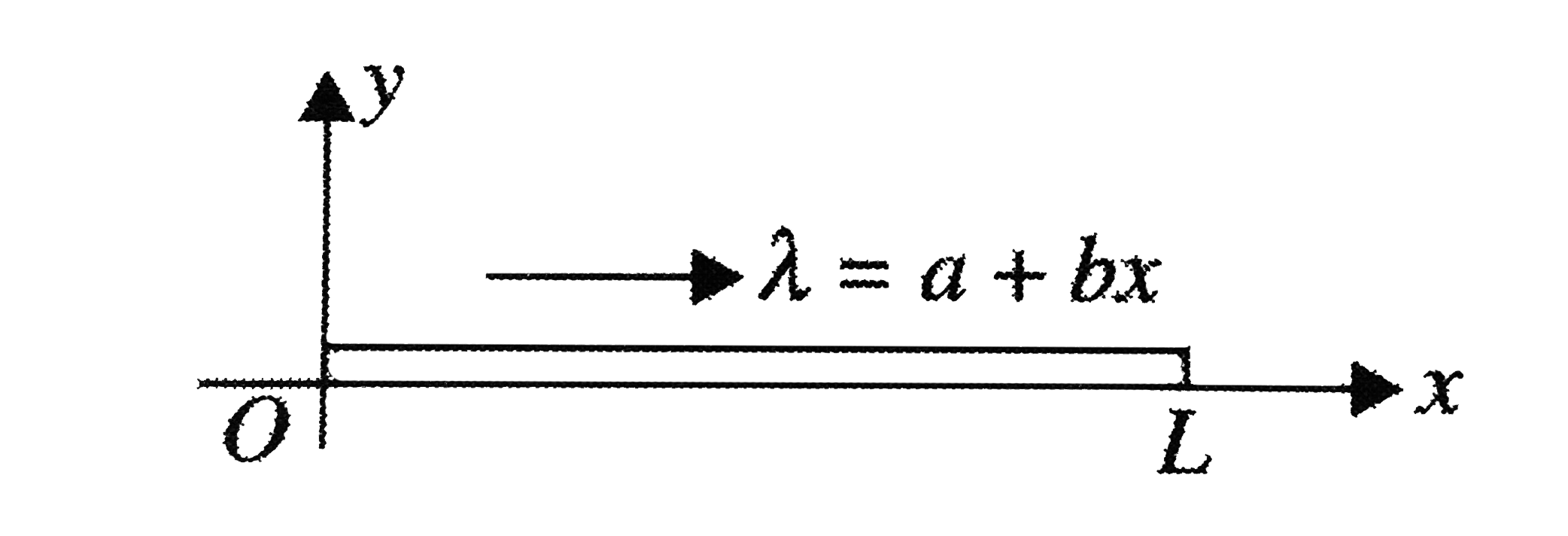The density of a non-uniform rod of length is given by
where a and b are constants and .
The centre of mass of the rod will be at
The correct Answer is:a
To find the center of mass of a non-uniform rod with a given density function, we can follow these steps:
1. Identify the Density Function:
The density of the rod is given by:
ρ(x)=a(1+bx2)
where a and b are constants, and 0≤x≤1.
2. Set Up the Expression for Center of Mass:
The center of mass xcm for a rod can be calculated using the formula:
xcm=∫L0x⋅ρ(x)dx∫L0ρ(x)dx
Here, L=1 meter.
3. Calculate the Numerator:
Substitute the density function into the numerator:
∫10x⋅ρ(x)dx=∫10x⋅a(1+bx2)dx
Expanding this gives:
=a∫10(x+bx3)dx
Now, calculate the integrals:
=a(∫10xdx+b∫10x3dx)
The integrals evaluate to:
∫10xdx=12and∫10x3dx=14
Thus, the numerator becomes:
=a(12+b⋅14)=a(12+b4)=2a+b4
4. Calculate the Denominator:
Now, calculate the denominator:
∫10ρ(x)dx=∫10a(1+bx2)dx
Expanding this gives:
=a(∫101dx+b∫10x2dx)
The integrals evaluate to:
∫101dx=1and∫10x2dx=13
Thus, the denominator becomes:
=a(1+b⋅13)=a(1+b3)=a⋅3+b3
5. Combine the Results:
Now substitute the results of the numerator and denominator into the center of mass formula:
xcm=2a+b4a(3+b)3=3(2a+b)4a(3+b)
6. Final Result:
Therefore, the center of mass of the rod is located at:
xcm=3(2a+b)4a(3+b)
The density of the rod is given by:
ρ(x)=a(1+bx2)
where a and b are constants, and 0≤x≤1.
The center of mass xcm for a rod can be calculated using the formula:
xcm=∫L0x⋅ρ(x)dx∫L0ρ(x)dx
Here, L=1 meter.
Substitute the density function into the numerator:
∫10x⋅ρ(x)dx=∫10x⋅a(1+bx2)dx
Expanding this gives:
=a∫10(x+bx3)dx
Now, calculate the integrals:
=a(∫10xdx+b∫10x3dx)
The integrals evaluate to:
∫10xdx=12and∫10x3dx=14
Thus, the numerator becomes:
=a(12+b⋅14)=a(12+b4)=2a+b4
Now, calculate the denominator:
∫10ρ(x)dx=∫10a(1+bx2)dx
Expanding this gives:
=a(∫101dx+b∫10x2dx)
The integrals evaluate to:
∫101dx=1and∫10x2dx=13
Thus, the denominator becomes:
=a(1+b⋅13)=a(1+b3)=a⋅3+b3
Now substitute the results of the numerator and denominator into the center of mass formula:
xcm=2a+b4a(3+b)3=3(2a+b)4a(3+b)
Therefore, the center of mass of the rod is located at:
xcm=3(2a+b)4a(3+b)
Topper's Solved these Questions
- SYSTEM OF PARTICLES AND ROTATIONAL MOTION BOOK - NCERT EXEMPLAR ENGLISHCHAPTER - SYSTEM OF PARTICLES AND ROTATIONAL MOTION EXERCISE - very short answer type questions
18 Videos
- SYSTEM OF PARTICLES AND ROTATIONAL MOTION BOOK - NCERT EXEMPLAR ENGLISHCHAPTER - SYSTEM OF PARTICLES AND ROTATIONAL MOTION EXERCISE - Long answer type questions
12 Videos
- OSCILLATIONSBOOK - NCERT EXEMPLAR ENGLISHCHAPTER - OSCILLATIONSEXERCISE - All Questions
36 Videos
- THERMAL PROPERTIES OF MATTERBOOK - NCERT EXEMPLAR ENGLISHCHAPTER - THERMAL PROPERTIES OF MATTEREXERCISE - Very short Answer type Questions
15 Videos
Similar Questions
The linear density of a non−uniform rod of length 2m is given by λ(x)=a(1+bx2) where a and b are constants and 0≤x≤2. The centre of mass of the rod will be at. X=
View SolutionThe centre of mass of a non uniform rod of length L, whose mass per unit length varies as ρ=k.x2L where k is a constant and x is the distance of any point from one end is (from the same end)
View SolutionThe linear density of a thin rod of length 1m lies as λ=(1+2x), where x is the distance from its one end. Find the distance of its center of mass from this end.
View SolutionA rod of length L is placed along the x-axis between x=0 and x=L. The linear mass density (mass/length) ρ of the rod varies with the distance x from the origin as ρ=a+bx. Here, a and b are constants. Find the position of centre of mass of this rod.
View SolutionThe linear mass density of a thin rod AB of length L varies from A to B as λ(x)=λ0(1+xL). Where x is the distance from A. If M is the mass of the rod then its moment of inertia about an axis passing through A and perpendicualr to the rod is :
View SolutionLinear mass density of a rod AB(of≤n>h10m) varies with distance x from its end A as λ =λ0x3 (λ0 is positive constant) . Distance of centre of mass of the rod , from end B is
View SolutionThe centre of mass of a non-uniform rod of length L whose mass per unit length λ is proportional to x2, where x is distance from one end
View SolutionLinear mass density of a rod AB ( of length 10 m) varied with distance x from its end A as λ=λ0x3 (λ0 is poitive constant). Distance of centre of mass the rod, form end B is
View SolutionYou are given a rod of length L. The linear mass density is λ such that λ=a+bx. Here a and b are constants and the mass of the rod increases as x decreases. Find the mass of the rod

View SolutionIf the linear mass density of a rod of length 3 m (lying fromy=0 toy=3m) varies as λ=(2+y)kg/m,then position of the centre of mass of the rod from y=0 is nearly at
View Solution
